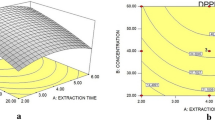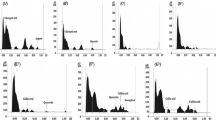Abstract
The antioxidative activity of 6 kinds of extracts including 80% ethanol, hexane, chloroform, ethyl acetate, butanol, and water from seeds and seedpods of lotus (Nelumbo nucifera Gaertner) were evaluated by determining DPPH and ABTS radical scavenging activities as well as ferric reducing ability of plasma (FRAP). DPPH and ABTS scavenging capacities of the ethyl acetate fraction of lotus seed (LS) were 94.6 and 91.9% and those of the water fraction of lotus seedpod (LSP) were 94.5 and 95.2% at 0.8 mg/mL. The ethyl acetate fraction of LS and the water fraction of LSP also showed high FRAP. The high antioxidant capacities of LS and LSP may be due to their flavonoid and proanthocyanidin contents. The evaluation of antioxidant effect in LS and LSP is a valuable purpose, particularly for finding an inexpensive source for natural antioxidants and functional food. The high antioxidant capacity of LSP water fraction could be available as natural additive in food.
Similar content being viewed by others
References
Mukherjee PK, Saha K, Pal M, Saha BP. Effect of Nelumbo nucifera rhizome extract on blood sugar level in rats. J. Ethnopharmacol. 58: 207–213 (1997)
Agnihotri VK, ElSohl HN, Khan SI, Jacob MR, Joshi VC, Smillie T, Khan IA, Walker LA. Constituents of Nelumbo nucifera leaves and their antimalarial and antifungal activity. Phytochem. Lett. 1: 89–93 (2008)
Ono YK, Hattori ER, Fukaya YKTK, Imai SJ, Ohizumi YSS. Antiobesity effect of Nelumbo nucifera leaves extract in mice and rats. J. Ethnopharmacol. 106: 238–244 (2006)
Jung HA, Jung YJ, Yoon NY, Jeong DM, Bae HJ, Kim DW, Na DH, Choi JS. Inhibitory effects of Nelumbo nucifera leaves on rat lens aldose reductase, advanced glycation endproducts formation, and oxidative stress. Food Chem. Toxicol. 46: 3818–3826 (2008)
Hettiarachchy NS, Glenn KC, Gnanasambandam R, Johnson MG. Natural antioxidant extract from fenugreek (Trigonella foenumgraecum) for ground beef patties. J. Food Sci. 61: 516–519 (1996)
Wichi HC. Safety evaluation of butylated hydroxytoluene (BHT) in the liver, lung, and gastrointestinal tract. Food Chem. Toxicol. 124: 1127–1130 (1986)
Grice HP. Enhanced tumour development by butylated hydroxyanisole (BHA) from the prospective of effect on forestomach and oesophageal squamous epithelium. Food Chem. Toxicol. 26: 717–723 (1988)
Chopra RN, Nayar SL, Chopra IC, Aslkar LV, Kakkar KK. Glossary of Indian Medicinal Plants. Council of Scientific & Industrial Research, New Delhi, India. p. 174 (1956)
Sohn DH, Kim YC, Oh SH, Park EJ, Li X, Lee BH. Hepatoprotective and free radical scavenging effects of Nelumbo nucifera. Phytomedicine 10: 165–169 (2003)
Mazumder UK, Gupta M, Pramanik G, Mukhopadhyay RK, Sarkar S. Antifertility activity of seed of Nelumbo nucifera in mice. Indian J. Exp. Biol. 30: 533–534 (1992)
Liu CP, Tsai WJ, Lin YL, Liao JF, Chen CF, Kuo YC. The extracts from Nelumbo nucifera suppress cell cycle progression, cytokine genes expression, and cell proliferation in human peripheral blood mononuclear cells. Life Sci. 75: 699–716 (2004)
Kredy HM, Huang DH, Xie BJ, He H, Yang EN, Tian BQ, Xiao D. Flavonols of lotus (Nelumbo nucifera Gaertn.) seed epicarp and their antioxidant potential. Eur. Food Res. Technol. 231: 387–394 (2010)
Ling ZQ, Xie BJ, Yang EL. Isolation, characterization, and determination of antioxidative activity of oligomeric procyanidins from the seedpod of Nelumbo nucifera Gaertn. J. Agr. Food Chem. 53: 2441–2445 (2005)
Jiqu X, Shuang R, Bijun X, Zhida S, Li Z, Hailei W, Ping Y, Liping H, Liegang L. Procyanidins extracted from the lotus seedpod ameliorate age-related antioxidant deficit in aged rats. J. Gerontol. A 65: 236–241 (2010)
Bagchi D, Garg A, Krohn RL, Bagchi M, Bagchi DJ, Balmoori J, Stohs SJ. Protective effects of grape seed proanthocyanidins and selected antioxidants against TPA-induced hepatic and brain lipid peroxidation and DNA fragmentation, and peritoneal macrophage activation in mice. Gen. Pharmacol. 30: 771–776 (1998)
Koleckar V, Kubikova K, Rehakova Z, Kuca K, Jun D, Jahodar L, Opletal L. Condensed and hydrolysable tannins as antioxidants influencing the health. Med. Chem. 8: 436–447 (2008)
Brand-Williams W, Cuvelier ME, Berset C. Use of a free radical method to evaluate antioxidant activity. Food Sci. Technol. 28: 25–30 (1995)
Re R, Pellegrini N, Proteggente A, Pannala A, Yang M, Rice Evans C. Antioxidant activity applying an improved ABTS radical cation decolorization assay. Free Radical Bio. Med. 26: 1231–1237 (1999)
Benzie IFF, Strain JJ. The ferric reducing ability of plasma (FRAP) as a measure of ‘antioxidant power’: The FRAP assay. Anal. Biochem. 239: 70–76 (1996)
Dongmei Y, Qiushuang W, Leqin K, Jianmei J, Tiejin Y. Antioxidant activities of various extracts of lotus (Nelumbo nuficera Gaertn) rhizome. Asian Pac. J. Clin. Nutr. 16: 158–163 (2007)
Sung JH, Sung JS, Shin HS. Cytoprotective effects of lotus (Nelumbo nucifera Gaertner) seed extracts on oxidative damaged mouse embryonic fibroblast cell. Food Sci. Biotechnol. 20: 1533–1537 (2011)
Miller NJ, Sampson J, Candeias LP, Bramley PM, Rice-Evans CA. Antioxidant activities of carotenes and xanthophylls. FEBS Lett. 384: 240–242 (1996)
Rice-Evans CA, Miller NJ, Bolwell PG, Bramley PM, Pridham JB. The relative antioxidant activities of plant-derived polyphenolic flavonoids. Free Radical Res. 22: 375–383 (1995)
Salah N, Miller NJ, Paganga G, Tijburg L, Bolwell GP, Riceevans C. Polyphenolic flavanols as scavengers of aqueous phase radicals and as chain-breaking antioxidants. Arch. Biochem. Biophys. 322: 339–346 (1995)
Yen GC, Duh PD, Su HJ, Antioxidant properties of lotus seed and its effect on DNA damage in human lymphocytes. Food Chem. 89: 379–385 (2005)
Yan BW, Li JZ, Jun Y, Jian GW, Chun JT, Ti QC, Jin ZW, Ka HW. A comparative study on antioxidant activity of ten different parts of Nelumbo nucifera caertn. Afr. J. Pharm. Pharmaco. 5: 2454–2461 (2011)
Kähkönen MP, Hopia AI, Vuorela HJ, Rauha JP, Pihlaja K, Kujala TS, Heinonen M. Antioxidant activity of plant extracts containing phenolic compounds. J. Agr. Food Chem. 47: 3954–3962 (1999)
Prior RL, Wu XL, Schaich K. Standardized methods for the determination of antioxidant capacity and phenolics in foods and dietary supplements. J. Agr. Food Chem. 53: 4290–4302 (2005)
Hong Y, Lin S, Jiang Y, Ashraf M. Variation in contents of total phenolics and flavonoids and antioxidant activities in the leaves of 11 Eriobotrya species. Plant Food Hum. Nutr. 63: 200–204 (2008)
Duthie SJ, Dobson VL. Dietary flavonoids protect human colonocyte DNA from oxidative attack in vitro. Eur. J. Nutr. 38: 28–34 (1999)
Bagchi D, Bagchi M, Stohs SJ, Das DK, Ray SD, Kuszynski C, Joshi SS, Pruess HG. Free radicals and grape seed proanthocyanidin extract: Importance in human health and disease prevention. Toxicology 148: 187–197 (2000)
Gong Y, Liu L, Xie B, Liao Y, Yang E, Sun Z. Ameliorative effects of lotus seedpod proanthocyanidins on cognitive deficits and oxidative damage in senescence-accelerated mice. Behav. Brain Res. 194: 100–107 (2008)
Author information
Authors and Affiliations
Corresponding author
Rights and permissions
About this article
Cite this article
Kim, MJ., Shin, HS. Antioxidative effect of lotus seed and seedpod extracts. Food Sci Biotechnol 21, 1761–1766 (2012). https://doi.org/10.1007/s10068-012-0234-7
Received:
Revised:
Accepted:
Published:
Issue Date:
DOI: https://doi.org/10.1007/s10068-012-0234-7




